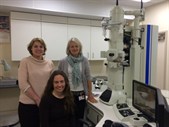A team of specialists at Royal Brompton Hospital and  University College London (UCL) have identified a new gene which causes the rare lung condition Primary Ciliary Dyskinesia (PCD).
University College London (UCL) have identified a new gene which causes the rare lung condition Primary Ciliary Dyskinesia (PCD).
Working with researchers from around Europe including hospitals in Italy, Switzerland and France, the team has shown that the condition can be 'X-linked' meaning it is passed from mothers to their sons. Their research is published in the Journal of Nature Communications.
PCD is an inherited condition where cilia, the tiny moving structures that line the airways, ears and sinuses are unable to function. Without the sweeping, wave-like motion of cilia the body is unable to keep these areas clean and free from infection.
The disease effects approximately 1 in 20,000 people, and although inherited in a similar way to cystic fibrosis it is often much more difficult to diagnose.
Children who are diagnosed with PCD are unable to protect their respiratory system and this can cause recurrent symptoms such as wet cough, chest infections and ear infections.
It is a condition diagnosed by examining cells under a powerful electron 3D microscope.
Dr Amelia Shoemark, senior clinical scientist in Primary Ciliary Dyskinesia and author of the paper said, “In people with this gene, we were able to identify that tiny parts of the lung, as small as nine millionths of a millimetre, were missing.
“3D technology is allowing us a more detailed understanding of PCD which improves our ability to make a diagnosis. We hope that ultimately discoveries such as these will provide new options for treatment.”
Dr Claire Hogg, Trust PCD lead, commented: “Children with PCD are often diagnosed late by which time significant lung damage can occur. Our gene discovery programme in partnership with University College London, is allowing us to make an earlier more accurate diagnosis. This in turn results in less lung damage.”
Fiona Copeland, Chair of PCD Family Support Group and mother of two sons with PCD said, “We discovered that my sons both had PCD when they were four and six years old, by which time my eldest had already developed bronchiectasis (irreversible lung damage) on a third of his right lung, earlier diagnosis may have prevented this from happening.
“We welcome any research that will help diagnosis children quicker so they can start their treatment regime earlier and help them stay as well as possible for longer.”
Royal Brompton Hospital is a national service for PCD and patients are referred following a positive diagnosis, or where a pre-existing diagnosis has been confirmed.
In 2014 Dr Amelia Shoemark, was awarded an NIHR Healthcare Science Post-Doctoral Fellowship for her work investigating new diagnostic tools for the condition.
The full article, ‘X-linked primary ciliary dyskinesia due to mutations in the cytoplasmic axonemal dynein assembly factor PIH1D3’, can be read in the journal of Nature Communications.
